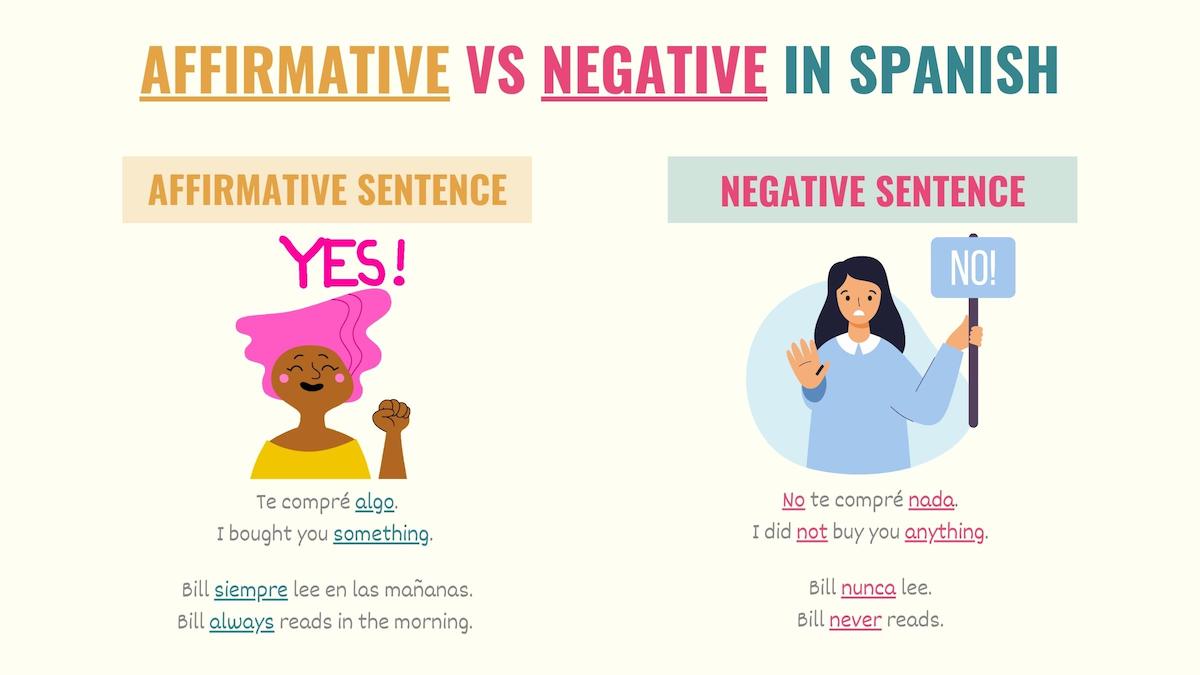Affirmative and negative words in Spanish are used to identify nouns and affirm or negate information. In short, knowing how to use affirmative and negatives is essential for your communication. With that in mind, in this guide, we’ll go over:
- List of Common Affirmative & Negative Words
- How to Make an Affirmative Sentence Negative
- Expressions with Spanish Affirmative and Negative Words
- Next Steps
Through this guide, you’ll learn the most common uses of these words and I’ll provide you with real-life examples of how to use them.
Let’s do this!
Spanish Affirmative and Negative Words
Below is a chart of affirmative words in Spanish and their negative counterpart:
| Affirmative word | Negative word | Use |
|---|---|---|
| Algo – Something | Nada – Nothing | Refer to things and ideas. |
| Algún – A, an, any, some | Ningún – Not any | Refer to people and things. |
| Alguien – Someone | Nadie – No one | Refer to people. |
| Alguno – Some / Someone | Ninguno – None / No | Replace nouns. They’re the pronoun forms of ‘algún’ and ‘ningún’. |
| Con – With | Sin – Without | Refer to accompanying something or someone. |
| O – Or | Ni – Nor | Provide options. |
| Sí – Yes | No – No | Affirm or negate information. |
| Siempre – Always | Nunca – Never | Indicate the frequency of an action. |
| También – Too, also | Tampoco – Neither, nor | Express agreement with a previous statement. |
Here are some important notes you should keep in mind:
- Algún and ningún are placed before singular masculine nouns. As Spanish adjectives, they have gender and plural form:
- ‘Algunos’, ‘alguna’, and ‘algunas’.
- Alguno and ninguno are indefinite pronouns. In other words, they take the gender and number of the noun they replace.
- También agrees with affirmative statements, whereas tampoco with negative sentences. These words are often placed before the verb.
- Algo and nada are invariable words, meaning they don’t have gender or number. These words can be used as pronouns or adverbs.
- As prepositions, con and sin are invariable.
Check these sentences using negative (negativo) and affirmative (afirmativo) words in Spanish:
¿Tendrás algún lápiz extra?
Would you have an extra pencil?
No sé nada de lo que pasó.
I know nothing about what happened.
Liam vino a la fiesta sin su esposa.
Liam came to the party without his wife.
¿Conoces a alguien que hable inglés?
Do you know someone who speaks English?
Sé que no querías nada, pero te traje algo.
I know you didn’t want anything, but I brought you something.
How to Turn Affirmative into Negative Sentences

As its name suggests, affirmative and negative words in Spanish are used in negative and positive sentences:
Affirmative sentence
Elena cocina muy bien.
Elena cooks very well.
Alguien vino a buscarte.
Someone came looking for you.
A algunos de mis hijos les gusta el brócoli.
Some of my children like broccoli.
Negative sentence
Elena no cocina muy bien.
Elena doesn’t cook very well.
Nadie vino a buscarte.
No one came looking for you.
A ninguno de mis hijos les gusta el brócoli.
None of my children like broccoli.
In Spanish, the most common way to turn an affirmative sentence into a negative one is by placing the word no before the conjugated verb.
No + verb
| Positive | Negative |
|---|---|
| El parque es muy bonito. The park is very pretty. | El parque no es muy bonito. The park is not very pretty. |
| Los niños se comieron la verdura. The kids ate their vegetables. | Los niños no se comieron la verdura. The kids did not eat their vegetables. |
To transform a sentence that uses an affirmative word, you must simply replace that term with its negative equivalent:
| Positive | Negative |
|---|---|
| ¿Alguno de ustedes sabe programar? Do any of you know how to program? | ¿Ninguno de ustedes sabe programar? None of you know how to program? |
| También queremos ir. We also want to go. | Tampoco queremos ir. We don’t want to go either. |
Notice that negative words are placed in front of the verb in these examples. However, some of these words can also be placed after the verb. In such cases, the Spanish double negative rules come into play.
Double negatives in Spanish
Double negatives in Spanish consist of using two negative words in a sentence. We do this when a negative comes after the verb:
No + [verb] + [negative word]
Nosotros no vimos nada.
We did not see anything.
James no vino con nadie.
James didn’t come with anyone.
No tengo perros ni gatos.
I do not have dogs or cats.
Alice no dejó ningún mensaje.
Alice did not leave any messages.
En esta fiesta, no conocemos a nadie.
We do not know anyone at this party.
As you can see from the examples above, double negation is formed by adding a negative term before the verb and another one after. With these structures, no is more commonly used as the first negative. However, you can also use other negatives instead:
Nadie me dijo nada.
Nobody told me anything.
These are the most common terms that we combined with no to form double negatives in Spanish:
- Nada
- Nadie
- Ningún / Ninguno
- Ni
- Nunca

Take Note: Although in English it is incorrect to use two negatives in a sentence, in Spanish, these structures are necessary for correct sentence structure.
Expressions with Affirmative and Negative Words in Spanish
Now that you know how Spanish affirmatives and negatives work, here are some common expressions with these terms that you can incorporate into your conversations:
- A no ser que: Unless
- Antes que nada: First of all / Before anything else
- Cómo no: You bet / Of course / No way
- Como si nada: As if it were nothing / Without a second thought
- De la nada: Out of nowhere
- De ninguna manera: No way
- Más que a nadie / nada: More than anyone / anything
- Mejor que nunca: Better than ever
- Ni hablar: Out of the question / Oh, well / No way
- Ni siquiera: Not even
- No me digas: You don’t say / No way
- Ser un don nadie: Be a nobody
- Uno nunca sabe: You never know
Me siento mejor que nunca.
I feel better than ever.
¡Ni hablar! No vas a ir a esa fiesta.
No way! You’re not going to that party.
Un carro nos salió de la nada.
A car came out of nowhere.
Te quiero más que a nada en el mundo.
I love you more than anything in the world.
¡Quemé el pastel! ¡Ni hablar!
I burnt the cake! Oh, well!
Key Points
Affirmative and negative words in Spanish are basic words that make your conversations clearer and more efficient. Here are some key points you should remember:
- Negatives and affirmatives in Spanish are used to identify people or things and to affirm or negate information.
- Depending on the word type, affirmatives and negatives:
- Refer to people, things, concepts (algo, algún, alguien, etc)
- Express agreement or disagreement (tampoco, también)
- Convey the relationship between a noun and other elements (con and sin)
- Express frequency (siempre and nunca)
- The formula negative word + verb is only used when using a single negative term in the sentence.
- Double negatives consist of using two negative words in a sentence (no + verb + negative).
Next Steps: Additional Resources
Spanish affirmative and negative words are basic words that you should know if you’re serious about learning this language. Most of these terms are pronouns, adjectives, and adverbs, which you should get familiar with to improve your conversations and expand your Spanish vocabulary. Here are some Spanish guides and resources to help you:
- List of Common Adverbs in Spanish
- How to Use Indefinite Adjectives & Pronouns
- What Are Adjectives in Spanish & How to Use Them
Because they look so similar, people often confuse algún and alguno. In this guide, you can check the uses and differences between these words.
Download the Spanish Negative & Affirmative Words PDF
I’ve created a free PDF you can download for this Spanish negative and affirmative words guide. It contains the list of affirmatives and negatives as well as the key points and rules for creating negative sentences.





